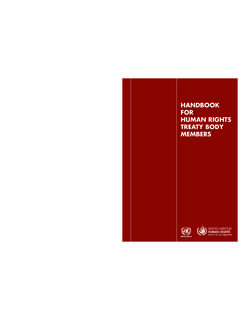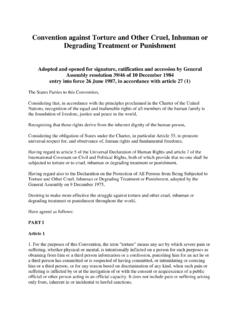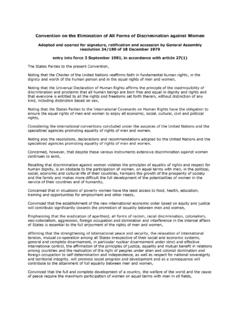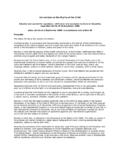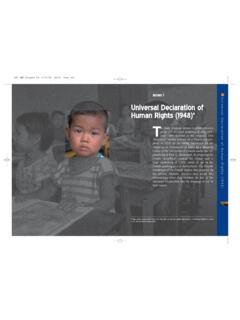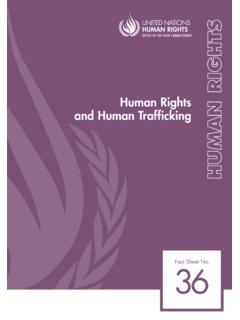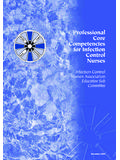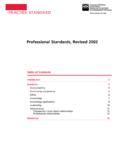Transcription of PROFESSIONAL TRAINING SERIES No. 6 Human Rights Training
1 HIGH COMMISSIONER FOR Human Rights CENTRE FOR Human Rights PROFESSIONAL TRAINING SERIES No. 6 Human Rights TRAINING A Manual on Human Rights TRAINING Methodology UNITED NATIONS HIGH COMMISSIONER FOR Human Rights CENTRE FOR Human Rights PROFESSIONAL TRAINING SERIES No. 6 Human Rights TRAINING A Manual on Human Rights TRAINING Methodology UNITED NATIONS New York and Geneva, 2000 UNITED NATIONS PUBLICATIONS ales 92-1-116726-4 ISSN 1020-16888 NOTEThe designations employed and the presentation of the material in thispublication do not imply the expression of any opinion whatsoever on the part ofthe Secretariat of the United Nations concerning the legal status of any country,territory, city or area, or of its authorities, or concerning the delimitation of its fron-tiers or boundaries.
2 **Material contained in this publication may be freely quoted or reprinted, pro-vided credit is given and a copy of the publication containing the reprinted materialis sent to the Office of the United Nations High Commissioner for Human Rights ,United Nations, 1211 Geneva 10, Human Rights TRAINING Collegial presentations ..21B. TRAINING the Interactive pedagogical Audience specificity .. practical approach .. presentation of standards ..72G. Teaching to Flexibility of design and application .. tools ..112K. The role of self-esteem .. to organizational policy ..132M. Planned EFFECTIVE TRAINING Learning Tailoring The participatory Participatory techniques .. for TRAINING courses .. for participants needs ..385 III. Selection of trainers.
3 39-407B. Briefing trainers ..417C. Instructions for Tips for making presentations .. terminology .. courses to challenging field AN INTRODUCTION TO Human Rights AND THEUNITEDNATIONS Wha tis mean tby Human righ ts ?..49-5010B. Some examples of Human Wha tis developmen t ? ..5211D. The righ t to developmen does a Rights -based approach to development differ from a needs-based approach ?.. do Human Rights rules come from? ..56-6411G. Who makes these rules? ..6512H. Where are the rules made?.. monitors Human Rights ? .. role of the High Commissioner for Human Rights ..7813K. Institution-building and technical cooperation .. How are Human Rights complaints and petitions handled? ..8414 ANNEX:The Universal Declaration of Human Rights ..151 CHAPTERIHUMAN Rights TRAINING METHODOLOGY1.
4 The Office of the United Nations High Commis-sioner for Human Rights (OHCHR) has been involved formanyyearsintrainingpersonsworkinginva riousprofes-sions in areas of Human Rights which touch on their partic-ular field of competence. The methodological approachdeveloped on the basis of the experience gained is com-prised of basic elements which, appropriately adapted andmodified for each target group, can provide useful guid-ance for the conceptualization, planning, implementationand evaluation of Human Rights TRAINING programmes foradul tprofessionals. These elemen ts are described Collegial presentations2. Fortheselectionofresourcepersons,OHCHR advises drawing from a list of experts which is practical inorientation. Rather than assembling panels composedentirely of professors and theorists, it is better to opt forpractitioners in the relevant field.
5 In the experience ofOHCHR, much more can be accomplished through a col-legial approach, in which developmen tprofessionals,police, or judges, for example, discuss these matters witheach other, than by a professor-student model of approach allows the trainer to access the distinctiveprofessional culture which surrounds each particular audi-ence. At the same time, practitioners/trainers should beaccompanied and supported by experts in Human Rights ,thus ensuring that the substance of international humanrights standards is fully and consistently reflected in thecourse TRAINING the trainers3. Participants in Human Rights TRAINING coursesshould be selected on the understanding that their respon-sibilities will continue after completion of the trainingexercise. Each will be charged with conducting his/herown TRAINING and dissemination efforts after returning tohis/her duty station.
6 In this way, the impact of suchcourses is multiplied as the information imparted is dis-seminated throughout the institutions concerned. Accord-ingly, in addition to substantive content, the coursesshould include TRAINING methodology and capacity-build-ing components, such as lessons and materials designed toimpart TRAINING skills to Interactive pedagogical techniques4. The courses developed by OHCHR and describedin these materials include a section designed to introducea variety of effective techniques for TRAINING adults. In par-ticular, suggestions are made for the use of creative, inter-active teaching methods, which offer the best hope forsecuring the active involvement of the programme par-ticipants. OHCHR has identified the following techniquesas especially appropriate and effective in Human rightstraining for adults: presentation and discussion, panel dis-cussion, working groups, case studies, problem-solving/brainstorming, simulation/role-playing, field trips, practi-cal exercises (including drafting), round-table discussionsand visual aids.
7 Pointers on the use of such techniques areprovided below in chapter Audience specificity5. OHCHR has learned that the mere recitation ofvague principles of general applicability offers little hopeof affecting the actual behaviour of a given audience. Tobe effective indeed, to be at all worthwhile trainingand education efforts must be directly targeted and appro-priately addressed to a particular audience, be they police,health-care workers, lawyers, students or developmentprofessionals. Accordingly, the content of OHCHR teach-ing materials focuses more on the standards directly rel-evant to the daily work of the PROFESSIONAL trainees andless on the history and structure of United A practical approach6. OHCHR TRAINING begins with the recognition thatprofessional groups in the real world want to know notjus twha t the Human righ ts rules are, bu talso how to dotheir job effectively within the confines of those bowing to instrumentalist approaches to humanrights, trainers must also recognize that professionals willalso wan t to know wha tis in i tfor them?
8 Tha tis, wha tvalue can a better understanding of Human Rights bring totheir work? TRAINING efforts which ignore either of theseareas are likely to be neither credible nor , trainers and course designers must includepractical information*on proven techniques for the per-formance of the actual duties of the participating profes-sionals, as derived from the recommendations of experts*While practical recommendations are a key component of coursesoffered under this approach, it would not be possible to provide detailedtraining on technical PROFESSIONAL skills in a Human Rights , the existence of such techniques should be highlighted andtargeted for further TRAINING as a follow-up to Human Rights TRAINING , andconceptual linkages should be made between the two sets of literature on the current best practice for the profes-sion in Comprehensive presentation of standards7.
9 These courses should be thorough in their presen-tation of the relevant international standards. To this end,relevant instruments and simplified learning tools shouldbe translated and distributed to participants. In every case,one or more persons specialized in Human Rights should beinvolved, to control the substantive content of the coursesand workshops, and to supplement course presentations Teaching to sensitize8. In addition to imparting standards and practicalskills, OHCHR courses should also include exercisesdesigned to sensitize trainees to their own potential forcontributing to violative behaviour, however example, well-developed exercises (including role-playing) which can make trainees aware of gender orracial bias in their own attitudes or behaviour can be val-uable.
10 Similarly, the special import of particular stand-ards as they apply to women, for example, is not alwaysobvious. Trainees should be made to understand that, forexample, the term degrading treatment , as found in var-ious international instruments, may imply different activ-ities and thresholds when applied to women as comparedto men, or to one cultural group as opposed to Flexibility of design and application9. To be universally useful, TRAINING courses must bedesigned in such a way as to facilitate their flexible use,without imposing a single rigid focus or approach on thetrainers. Courses must be adaptable to the particular cul-tural, educational, regional and experiential needs andrealities of a diverse range of potential audiences withinthe target group. Accordingly, course materials should notbe intended to be read verbatim to trainees.
